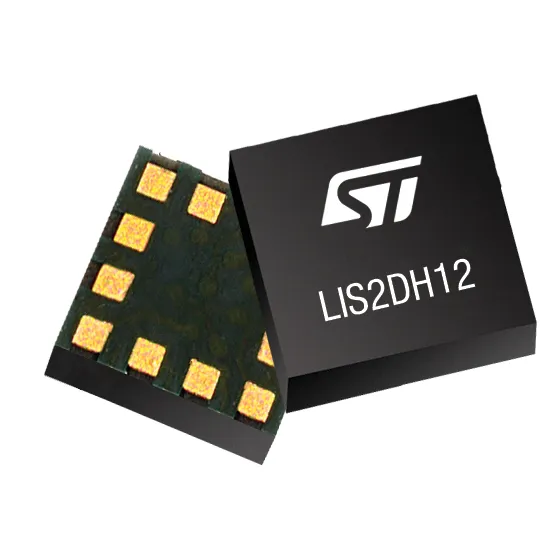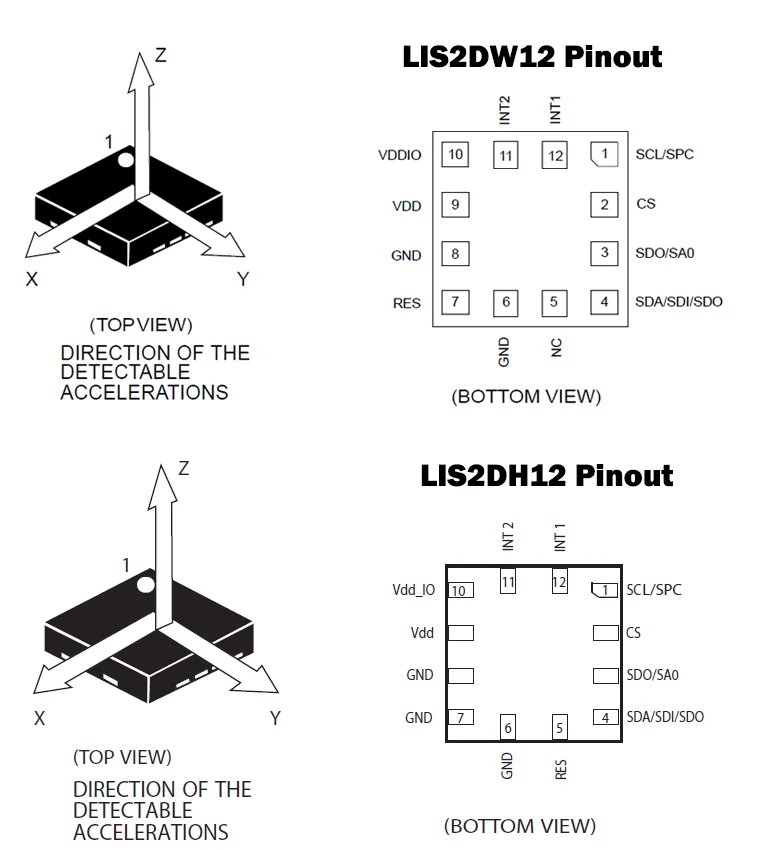While the basic functionality of the LIS2DW12 and LIS2DH12 sensors to detect motion is similar, their capabilities and applications vary, making each sensor suitable for specific use cases. In this blog, we will conduct an in-depth comparative analysis of LIS2DW12 datasheet and LIS2DH12 datasheet based on their respective technical documents.
Overview of LIS2DW12 and LIS2DH12
What is LIS2DW12?
The LIS2DW12 is a high-performance, ultra-low power 3-axis linear accelerometer from STMicroelectronics. It's part of their MEMS (microelectromechanical systems) product line and is designed to provide precise acceleration measurements across various applications such as wearable devices, IoT solutions, and gaming peripherals.

LIS2DW12 Package and Pin Configuration
Notable for its exceptional energy efficiency, the LIS2DW12 offers multiple operating modes that allow users to balance between performance requirements and power consumption. Its high-resolution output coupled with lower noise levels in high-resolution mode make it a robust choice for precision-oriented applications. The device supports both I²C and SPI interfaces offering flexibility in communication with other hardware or microcontrollers. Moreover, it comes equipped with several embedded functionalities like freefall detection, tap recognition, wake-up events which can optimize system-level operations.
Operating within an extended voltage range from 1.62V up to 3.6V makes it adaptable to diverse design requirements while maintaining low power consumption.
What is LIS2DH12?
The LIS2DH12 is a low-power, high-performance 3-axis linear accelerometer belonging to the nano family from STMicroelectronics. It's designed as part of their MEMS (microelectromechanical systems) product line and is intended for applications such as motion-activated functions, free-fall detection, and more.

LIS2DH12 Package and Pin configuration
This device offers multiple operating modes that allow users to balance between power consumption and performance. While not quite as energy-efficient as its counterpart, the LIS2DW12, it nonetheless has a respectable power profile. The sensor provides high-resolution output with slightly higher noise levels in high-resolution mode compared to newer models like the LIS2DW12. It supports both I²C and SPI interfaces for versatile communication options with other devices or microcontrollers. Additionally, it comes equipped with several embedded functionalities such as freefall detection and 6D/4D orientation detection which can optimize system-level operations. Operating within a voltage range from 1.71V up to 5V makes it adaptable across diverse designs.
Specifications Comparison: LIS2DW12 vs LIS2DH12
LIS2DW12 vs LIS2DH12 Specifications| Specifications | LIS2DW12 | LIS2DH12 |
|---|
| Supply Voltage-Max (Vsup) | 3.6 V | 3.6 V |
| Supply Voltage-Min (Vsup) | 1.62 V | 1.71V |
| Terminal Pitch | 0.5 mm | 0.5 mm |
| Noise Density | 90 µg/√Hz | 150 µg/√Hz |
| Measurement range | ±2, ±4, ±8, or ±16 g | ±2, ±4, ±8, or ±16 g |
| Output data rate | 6.66 kHz | 6.66 kHz |
| Shock Survivability | 10,000 g | 2,000 g |
Application Comparison: LIS2DW12 vs LIS2DH12
LIS2DW12 is mainly suitable for the following applications:
Motion detection for wearables
Gesture recognition and gaming
Motion-activated functions and userinterfaces
Display orientation
Tap/double-tap recognition
Free-fall detection
Smart power saving for handhelddevices
LIS2DH12 is mainly suitable for the following applications:
Motion-activated functions
Display orientation
Shake control
Pedometer
Gaming and virtual reality input devices
Impact recognition and logging.
Electrical connections Comparison: LIS2DW12 vs LIS2DH12
Both the LIS2DW12 and LIS2DH12 device cores are powered via the Vdd line, while the I/O pads are powered via the Vdd_IO line. Power supply decoupling capacitors (100 nF ceramic, 10 μF aluminum) should be placed as near as possible to pin 9 of the device (common design practice).
However, there are detailed differences in their Electrical connections, as shown in the figure below:

LIS2DW12(top) vs LIS2DH12(below) Electrical connections
Pin Configuration: LIS2DW12 vs LIS2DH12
We've compared the pin configurations of STMicroelectronics' accelerometers, LIS2DW12 and LIS2DH12.

LIS2DW12(Top) vs LIS2DH12(below) Pin Configuration
The two devices share many similarities in their pin functions such as:
SCL/SPC (Pin 1) for I²C serial clock or SPI serial port clock, CS (Pin 2) for SPI enable / I²C-SPI mode selection, and SDO/SA0 (Pin 3(1)) as an SPI data output or I²C address select.
Pin 4 is used for data input/output depending on whether you're using an I2C or SPI protocol.
A notable difference occurs at Pin 5: In the LIS2DW12 it's a No Connection (NC) that can be tied to VDD, VDDIO, or GND based on design requirements while in the LIS2DH12 (Res), it needs to be connected to Ground. Both have similar power supply pins (Vdd, Vdd_IO) and ground pins (GND).
Interrupt Pins(NT1, INT2) serve similar purposes across both sensors except that INT_ on LISDHW also serves as Clock input when single conversion mode is selected.
LIS2DW12 vs LIS2DH12 Block Diagram
LIS2DW12 and LIS2DH12 Block Diagram are very similar, with only minor differences, as shown in the figure below:

LIS2DW12 Block Diagram vs LIS2DH12 Block Diagram
Package outline and mechanical data: LIS2DW12 vs LIS2DH12
LIS2DH12 vs LIS2DW12 OUTER DIMENSIONS| ITEM | LIS2DH12 | LIS2DW12 |
|---|
| Length[L] | 2.00(±0.15) | 2(±0.1) |
| Width [W] | 2.00(±0.15) | 2(±0.1) |
| Height[H] | 1.0(MAX) | 0.7(MAX) |
Length (L): Both have a similar length of 2.00 mm (with a slight variation in tolerance).
Width (W): Both share the same width of 2.00 mm (with a slight variation in tolerance).
Height (H): The LIS2DW12 is slightly shorter with a maximum height of 0.7 mm compared to the LIS2DH12's maximum of 1.0 mm.

LIS2DW12 and LIS2DH12 Package outline and mechanical data
How to choose: LIS2DW12 vs LIS2DH12
The LIS2DW12 and LIS2DH12 are both 3-axis MEMS accelerometers from STMicroelectronics. Here's a brief comparison:
Power Consumption: The LIS2DW12 has an ultra-low-power design, consuming less than 1 μA in low power mode, making it ideal for battery-powered or energy-sensitive applications.
Performance: The LIS2DW12 offers lower noise levels (down to 90 μg/√Hz) compared to the LIS2DH12, providing better precision.
Data Output Rate: The data output rate of the LIS2DW12 is more flexible, ranging from 1.6 Hz up to 1600 Hz.
Motion Detection Features: The dedicated internal engine in the LIS2DW12 provides advanced motion detection capabilities such as free-fall detection, wakeup detection, single/double-tap recognition and activity/inactivity detection which may be superior compared with those in the older model -LIS2DH12.
Temperature Range: Both sensors operate over a wide temperature range (-40 °C to +85 °C).
In summary: If you prioritize ultra-low power consumption and advanced motion detection features with better performance at lower noise levels, go for the newer model -LIS2DW12.
Same series models of LIS2DW12 and LIS2DH12
The same series of models of LIS2DW12 and LIS2DH12 include: LIS2DE12, LIS2DS12, LIS2DTW12, LIS2DU12, LIS2DUX12, LIS2DUXS12, PVL-LIS2DUX12QC, LIS2DE(OBSOLETE) and LIS2DM(OBSOLETE)
LIS2DW12 vs LIS2DH12 Alternative Parts
Alternative parts for the LIS2DW12 include the LIS2DWLTR, Bosch Sensortec BMA400( A low-power 3-axis accelerometer), InvenSense (TDK) ICM-20602(combines a 3-axis gyroscope, and a 3-axis accelerometer), Analog Devices ADXL362(An ultra-low power, 3-Axis MEMS accelerometer), NXP MMA8451Q,Kionix (Rohm) KXTJ3-1057,LIS2DW12TR, LIS2DW12P, LIS2DW12D and LIS2DW12DL.
Alternative parts for the LIS2DH12 include the Bosch Sensortec BMA253(A 3-axis accelerometer with signal conditioning), InvenSense (TDK) MPU-6050(A popular 6-axis motion tracking device), Analog Devices ADXL345, NXP MMA8452Q(This is a small, thin, low power consumption 3-Axis MEMS accelerometer), Kionix (Rohm) KXTJ2-1009, LIS2DH12TR, LIS2DH12P, LIS2DH12D, LIS2DH12DL, and LIS2DE12.
Summary
In summary, the decision between the LIS2DW12 and LIS2DH12 motion sensors should be guided by the particular demands of your project. Each sensor brings its own set of strengths to the table:
The LIS2DW12 is noteworthy for its minimal power usage and enhanced shock resistance, which makes it a prime candidate for wearable devices and applications that prioritize durability and energy efficiency.
On the other hand, the LIS2DH12 excels in areas requiring acute motion detection due to its low noise levels and high sensitivity. This sensor is particularly advantageous for gaming interfaces, virtual reality equipment, and industrial automation tasks.
Choosing the right motion sensor is vital to the success of your project, as it can greatly influence both performance and efficiency. It's important to conduct a comprehensive evaluation of your options to ensure the best possible outcome.
Frequently Asked Questions
1. LIS2DW12 and LIS2DH12 Which one is better?
The choice between LIS2DW12 and LIS2DH12 depends on your application. The former offers lower power consumption, making it ideal for battery-powered devices, while the latter is suitable if you have less stringent power requirements or need compatibility with older designs.
LIS2DW12 is better for energy efficiency and durability, while LIS2DH12 is superior for precise motion detection.
2. Which one is larger, LIS2DW12 or LIS2DH12?
The LIS2DH12 is typically larger than the LIS2DW12. Because their length and width are the same (ignoring deviation), and the maximum height of LIS2DH12 is 1mm, and the maximum height of LIS2DW12 is 0.7mm
3. Which one is more stable, LIS2DW12 or LIS2DH12??
The LIS2DH12 is generally more stable due to its lower noise levels and high sensitivity.